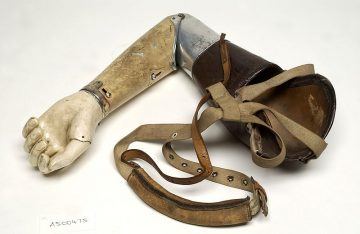by Godfrey Onime

Consider the case of James Edward Hanger, who was only 18 when the American civil war erupted. A promising engineering student, he left his studies at Washington College (now Washington & Lee University) to enlist in the military. The date was June 1, 1861.
Fate had other plans for the young man other than remaining a fighting soldier. On June 3rd, only two days after enlisting, Hanger was engaged at the Battle of Philippi (then in Virginia, and now West Virginia) when a cannonball ripped through his leg. To save his life, Hanger underwent a painful amputation of the limb, earning him the distinction of becoming the war’s first amputee. Returning to his family by August, the young man retreated into a solitude in his room, to the worry of his parents. Hanger was quoted as saying,
“No one can know what such a loss means unless he has suffered a similar catastrophe. In the twinkling of an eye, life’s fondest hopes seemed dead. What could the world hold for a maimed, crippled man?”
***
It is not difficult to understand how the young Hanger could have felt that way. Throughout history, many have shown contempt for the crippled — and even those who found themselves injured or captured in war. And in recent years, no less a powerful man than the president of the United States have publicly decried those who were killed in battle, maimed, or captured. For instance, while running for the Republican nomination for president of the United States in 2015, Donald J Trump famously lambasted the late John McCain who had spent more than five years as prisoner of war of the North Vietnamese. “He’s not a war hero,” Trump had said of the then U.S Senator and former republican presidential nominee. “I like people who weren’t captured.” And just last week, The Atlantic reported that the president had said that Americans who died in war are “losers” and “suckers.”
The Atlantic’s story also shed some light on the president’s impression of amputees. It alleged that during a 2018 White House planning meeting for a military parade, the president requested that the celebration event excluded wounded veterans such as amputees because he believed “Nobody wants to see that.”
Indeed, the injured and maimed 18-year-old Hanger must have had every reason to worry. He must have been aware that there were perhaps many during his time who saw those wounded at war as weak and “losers,” as there are the alleged Donald Trumps of today. Afraid that he might become the laughing stock of an often unforgiving society, Hanger knew he must literally get back on his feet. His answer would rest in prosthetics — and his experience would radically change the world of prosthetic limbs.
***
The loss of limbs can result from many insults: automobile and other accidents, diseases and illness such as diabetic non-healing ulcers, or some people who were born without limbs. Stroke and infections such as paralytic polio can lead to loss of limb-function. But throughout history, wars have been responsible for most loss of limbs. And not surprising, the same wars have revolutionized the technological advancements in both amputations and the development of prosthetic limbs. Far from a modern invention, one of the earliest examples of a prosthetic limbs appears to date back to almost 1,000 years before Christ (about 950 BC). Specifically, it was a big toe belonging to an Egyptian noblewoman. It happens that Egyptian culture back then placed much concern on wearing their sandals– and you could not wear the traditional Egyptian thong sandals without a big toe. Historians believe that for this woman, wearing a prosthetic toe was both functional and continued to affirm her identity as an Egyptian and a noblewoman.
Another early discovery of prosthesis dates to Roman times (approximately 300 BC) and was discovered in Capua, Italy. It had a wood core, bronze shims and leather straps.
Also, the Roman General Marcus Sergius reportedly lost his right arm and was fitted with an iron hand in which to hold his shield so he could return to the battlefront around 218-210 BC. That’s correct — the earliest prosthetic limbs included those developed to allow men to return to their occupations as fighting soldiers.
Through the years, the increasingly sophisticated weaponry of wars have left many solders — and often civilians — who escaped being killed or paralyzed to become limbless. Consider the American civil war. Though he was it’s first amputee, Hangar was hardly the only one to lose his limb to the war. Approximately 60,000 men had limbs amputated between 1861 and 1865, and often without anesthesia. Such circumstances inspired scores of physicians to advance prosthetics during the American Civil War, among them Dr. Douglas Bly of Rochester, New York. Many like Dr. Bly sought government contracts while others sold their prosthetic directly to the individuals.
Prior to the Civil War, the typical prosthetic was a “peg leg”; though the leg itself often contained wood, it also commonly used iron, other metals or stone, which made it a very heavy limb. When the wearer was seated, it often took a great deal of control to keep the leg still, resulting in back pain. It often was put on through the use of leather straps; sometimes catgut tendons were used.
What made Dr. Bly’s prosthetic limb superior to earlier designs was his knowledge of human anatomy and specifically the way the leg works at the ankle. His limb allowed for side motion instead of simply forward and backward, and mechanisms at both the ankle and the knee allowed for more natural bending and flexing. In fact, Dr. Bly was credited with inventing the first curved knee. The ankle movement was obtained through the use of a polished ball inside a socket of vulcanized rubber. Unfortunately, Dr. Bly’s invention was considered too expensive for a government contract.
Entered James Hanger — the 18-year old engineering-student-turn-soldier who had his limb shattered after just two days. It turned out that when he retreated to his room, he was not wallowing in self-pity, as his parents had feared. Rather, he took to heart the oft-said phrase “necessity is the mother of invention” and went to work fashioning a practical prosthetic limb. Three months later, by November 1861, he had developed The Hanger Limb. Like Dr. Bly’s prosthetic, it contained a hinged knee and ankle that allowed for greater mobility.
Not only did Hanger’s limb pay attention to sophistication, it also considered cost. Before the end of the year, he had obtained a contract with the Confederate States of America to develop prosthetic legs for Confederate soldiers, and in 1891, he was given a United States patent for his invention.
Developing prosthetic limbs was big business by the civil war and investors clamored to join the gold rush — almost 150 patents were issued between 1861 and 1873. The American Civil War was the first time in recorded history that a government committed to paying for artificial limbs for veteran amputees. The United States Government gave Union soldiers $75 to buy a leg and $50 for an arm, and the Confederate Government also provided financial help.
The inventions during the Civil War were to be the largest leap in prosthetic technology until 1946 when the suction sock was developed by UC Berkeley.
***
In recent years though, prosthetic limbs have become a marvel of medical technology and robotics that use sensors that mimic human nerves and are capable of adjusting automatically to activity level, terrain and movement. They are complex machines that integrate Bluetooth technology, hydraulics and software. And some are now able to harness the power of the mind, translating what the person is thinking into movements of the limbs.
Consider the invention of Easton LaChappelle. At age 16, bored in class and deciding he wanted to do something with his life, he embarked on building a 3D mind-controlled prosthetic limb. His inspiration: seeing a little girl with a basic prosthetic arm that had cost her family more than $80,000 and which needed replacing every year as the girl grew. “it was almost a burden for the family,” LaChappelle told BBC.
But the teenage LaChappelle had no knowledge of how the brain worked. What he knew was how to take things apart and put them back together. He turned to a simple game called Mindflex that allows players to control a ball with their thoughts. Purchasing and taking the game apart, he investigated how different movements were connected to particular brainwaves. By age 19, he had built an arm whose actions could be controlled by the wearer’s thoughts. The cost to make one? $500.
Today prosthetics can be covered with materials that resemble human skin, such as Fillauer’s Dream Skin that currently comes in 18 different skin tones. Carbon fiber is one material that is making prosthetics lighter than earlier models, and now 3D printing can be used both for the prosthetic and for the skin or cover.
Indeed, the evolution of the artificial limb is just another marvel of human geniuses and resilience, and of the contributions of technology to all walks of life. But it also tells of the struggles of many men and women who were unfortunate enough to fall victims to injury, illness or genetics–and yes, military combat, fighting for freedom. Thanks in some parts to the wonders of prosthetic limbs, it is worth celebrating how these people have been able to gather the pieces and learn to walk again, run, climb, dance, swim, throw a ball — and in the case of the Roman general, return to war.

And of course, let’s not forget the wounded like the 18-year old Hanger, who though did not return to war, harnessed his personal experience to revolutionized prosthetic limbs.
The “Hanger Limb” was first worn by James Hanger himself in November 1861. As he descended the steps of his home, his parents watched wide-eyed and open-mounted, their pleasant amazement palpable. They must have thought, “So this was what our son had been up to, locked away these past three months?”
It may surprise some who have read this far that Hanger had been enlisted with the confederate army. But the prosthetic limbs he revolutionized have helped many in both sides of the conflict and the world beyond. Hanger had subsequently expanded his service to civilians. And long after he retired, he continued to prioritize a dedication to others who had suffered a similar fate as he had, whether through wars, accidents, or illness. In 1915, he crisscrossed to Europe to assist in advancing prosthetic care to the wounded during World War I. By the time of his death in June 1919, the J.E. Hanger Company was already a world leader. It had branches in Atlanta, Philadelphia, Pittsburgh, St. Louis, London, and Paris. Today, a national, $1 billion-plus, publicly-traded company, Hanger, Inc. is still a leader in prosthetic limbs, offering more than 400,000 orthotic and prosthetic products and treating more than one million patients each year.
What could the world hold for a maimed, crippled man? Here’s what Hanger had to say later in life,
“Today I am thankful for what seemed then to me nothing but a blunder of fate, but which was to prove instead a great opportunity.”
So, dear reader, whenever you see a person wearing a prosthetic arm or leg, in whatever make or function, please take a moment to appreciate what they have endured — and to thank the many geniuses who labored to make their prosthetic limbs possible, refusing to believe for one minute that these people are “losers” and “suckers.”
